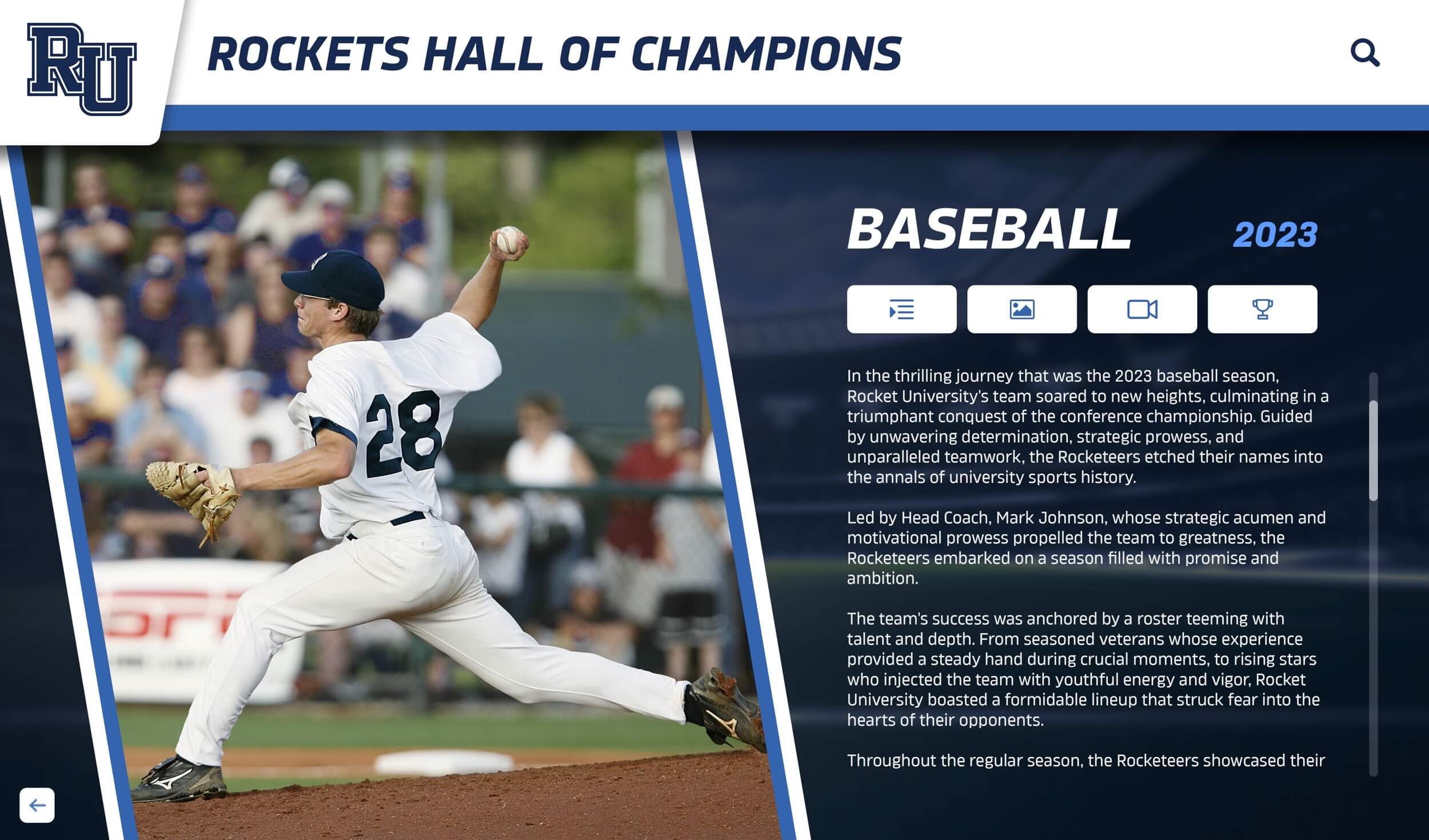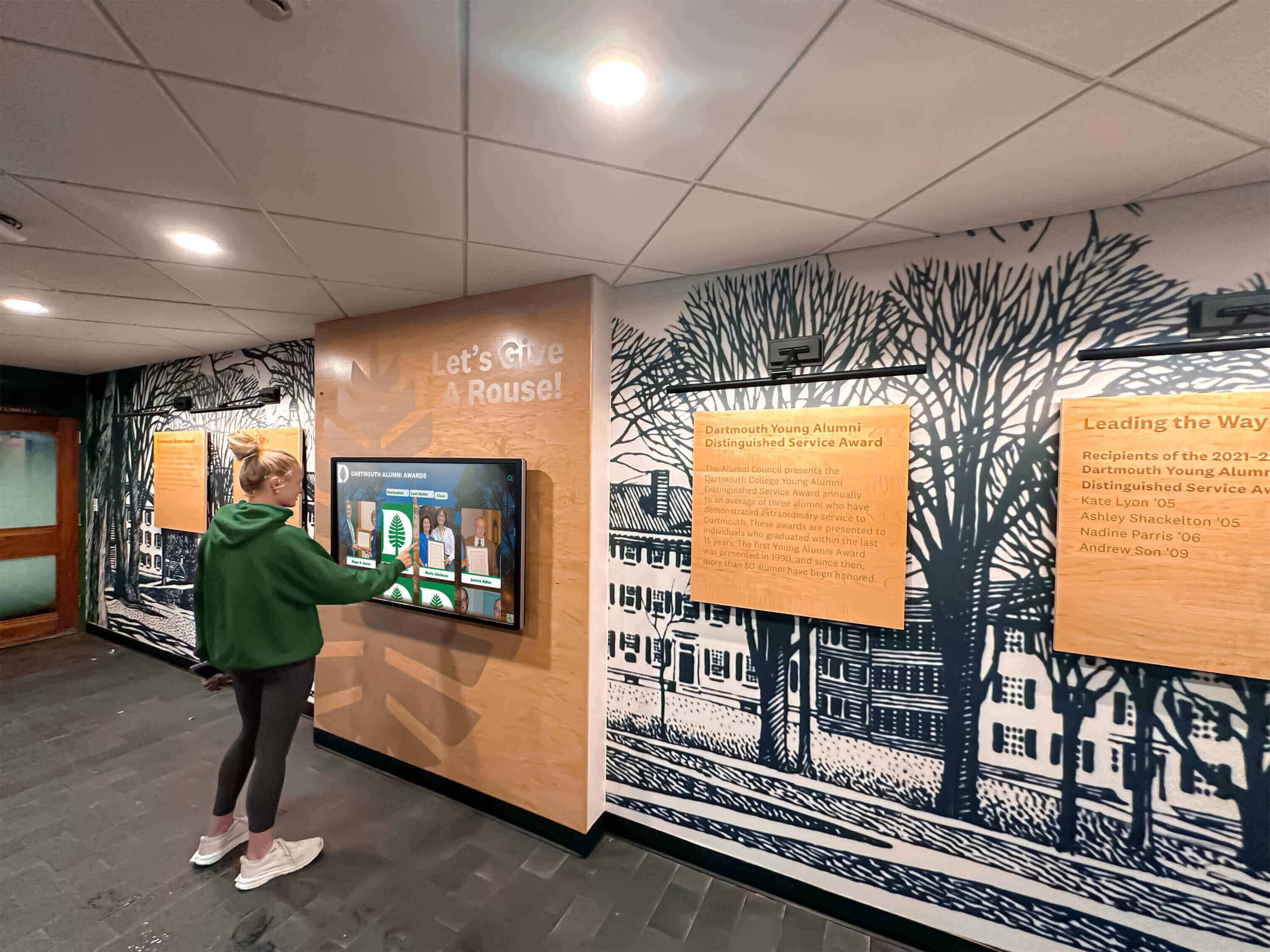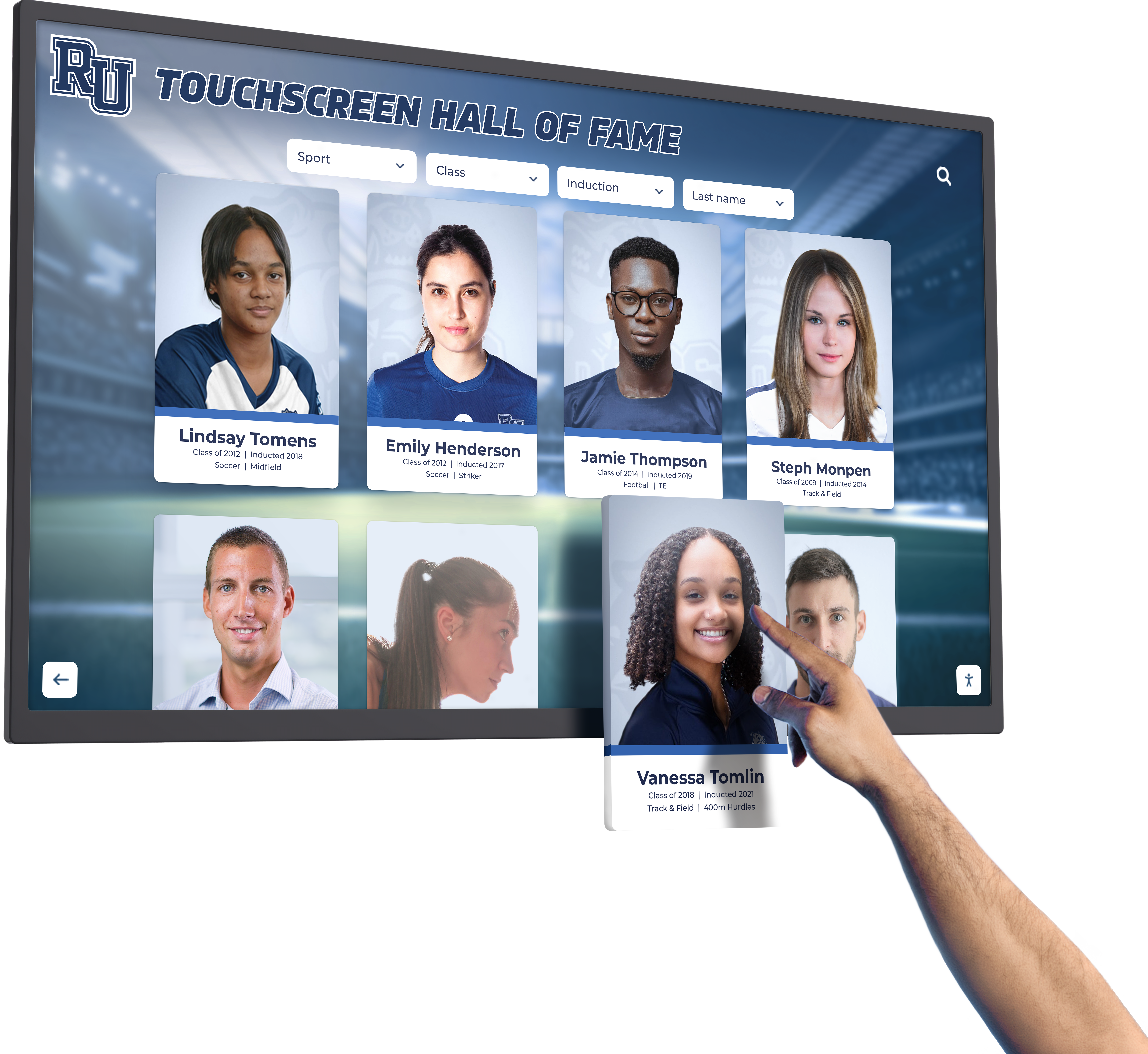The Masters Tournament stands as golf’s most prestigious event, where legends are made and history unfolds each April at Augusta National Golf Club. For organizations celebrating golf heritage, commemorating tournament achievements, or honoring the sport’s greatest moments, interactive touchscreen displays offer powerful ways to bring The Masters’ rich history to life. Whether you’re a golf club, sports museum, country club, or educational institution with golf programs, digital recognition technology transforms how you showcase golf excellence, preserve tournament history, and engage audiences with the sport’s most revered championship.
This comprehensive guide explores how touchscreen technology celebrates The Masters Tournament, from champion recognition and historical documentation to engaging presentation strategies that bring golf heritage to life for diverse audiences.
The Masters Tournament: Golf’s Most Prestigious Tradition
Understanding The Masters’ unique place in golf history provides essential context for creating meaningful recognition displays that honor the tournament’s significance and cultural impact.
A Championship Like No Other
The Masters Tournament, held annually since 1934 at Augusta National Golf Club in Augusta, Georgia, represents one of golf’s four major championships alongside the U.S. Open, The Open Championship (British Open), and the PGA Championship. However, The Masters occupies a special place in golf culture through several distinguishing characteristics.

The tournament’s consistency of location—always at Augusta National—creates unique continuity that other majors lack. Golfers compete on the same hallowed grounds where legends like Jack Nicklaus, Arnold Palmer, Tiger Woods, and Bobby Jones made history. This geographic permanence allows deep familiarity with the course, its challenges, and its traditions.
Augusta National’s iconic features have become synonymous with golf excellence. Amen Corner (holes 11, 12, and 13), Magnolia Lane’s tree-lined entrance, and the azalea-adorned landscape create instantly recognizable imagery that transcends the sport. The Masters’ Green Jacket, awarded to each champion, represents one of sports’ most coveted prizes and enduring symbols of achievement.
Tournament Traditions and Cultural Significance
The Masters maintains traditions that distinguish it from other sporting events and contribute to its mystique. The Champions Dinner, where past winners gather the Tuesday before the tournament, creates an exclusive fraternity of champions. The Par 3 Contest on Wednesday provides lighthearted competition on Augusta National’s Par 3 course, where many champions’ families participate.
The tournament’s broadcasting traditions have shaped how golf is presented to audiences worldwide. CBS’s coverage, with its hushed tones and minimal commercialization, treats the event with reverence. The Masters’ website and app provide comprehensive historical data, making tournament history accessible to modern audiences while honoring tradition.
For golf organizations creating recognition displays, The Masters Tournament offers rich content spanning championship victories, memorable moments, course evolution, player achievements, and cultural significance that resonates with golf enthusiasts and general audiences alike.
Why The Masters Tournament Deserves Recognition Displays
Golf clubs, sports museums, country clubs, and educational institutions with golf programs benefit from showcasing Masters history through several compelling reasons.

Inspiring Golf Excellence
The Masters represents the pinnacle of golf achievement, making it an ideal subject for displays that inspire current golfers. When young players see Jack Nicklaus’s record six Green Jackets or Tiger Woods’s dominant victories, they understand what excellence requires. When club members view displays showcasing Masters champions who once played their home course, the tournament feels more accessible and relevant to their own golf journeys.
Recognition displays featuring Masters content create tangible connections between recreational golfers and professional excellence. Stories of champions overcoming adversity—whether Phil Mickelson’s first major victory at age 33 or Bubba Watson’s improbable playoff wins—demonstrate that perseverance and creativity matter as much as raw talent in achieving success.
Celebrating Golf Heritage and History
The Masters’ nearly 90-year history documents golf’s evolution through changing equipment, playing styles, and cultural contexts. Touchscreen displays can present this evolution through timeline presentations showing how the tournament and sport have developed, champion profiles spanning different eras demonstrating evolving approaches, course modification documentation revealing how Augusta has adapted, and cultural context explaining The Masters’ impact beyond golf.
For organizations with golf history collections—vintage equipment, photographs, memorabilia, or documents—The Masters provides natural thematic frameworks for presenting materials. Digital displays can contextualize physical collections, explaining how artifacts relate to tournament history and golf’s broader evolution.
Engaging Diverse Audiences
While die-hard golf fans naturally engage with Masters content, well-designed recognition displays appeal to broader audiences through human stories, dramatic moments, beautiful imagery, accessible explanations, and connections to popular culture. The Masters’ visual beauty—Augusta National’s azaleas, dogwoods, and manicured landscapes—creates aesthetic appeal transcending sport. Memorable moments like Gene Sarazen’s “shot heard ‘round the world” or Jordan Spieth’s collapse and recovery provide dramatic narratives engaging even casual observers.
Interactive touchscreen technology particularly benefits Masters recognition by allowing visitors to explore content matching their interest levels. Golf enthusiasts can dive deep into statistical analyses and shot-by-shot recaps while casual viewers browse highlights and beautiful imagery without feeling overwhelmed by technical detail.
Content Strategies for Masters Tournament Recognition Displays
Effective Masters recognition displays balance comprehensive information with engaging presentation, creating experiences that educate, inspire, and entertain diverse audiences.

Champion Recognition and Player Profiles
The Masters’ champion roster reads like golf’s greatest hits, providing rich content for recognition displays. Comprehensive champion databases should include complete winner listings from 1934 to present, winning scores and tournament statistics, victory narratives describing how championships were won, career contexts showing where Masters victories fit in players’ achievements, and memorable moments from championship rounds.
Featured player profiles can highlight golf’s greatest champions through multiple Masters victories—Jack Nicklaus’s six wins, Arnold Palmer’s four Green Jackets, Tiger Woods’s five victories, or Gary Player’s international success. These profiles should include biographical information spanning childhood through professional careers, playing style analyses explaining what made champions effective at Augusta, signature shots and memorable moments defining their Masters legacies, and post-victory impacts showing how Masters wins influenced careers and golf history.
Solutions like digital record boards for golf provide frameworks for organizing and presenting player achievement data in engaging formats that highlight individual excellence while showing broader tournament patterns.
Tournament History and Memorable Moments
Beyond individual champions, The Masters offers decades of dramatic moments, unexpected outcomes, and golf’s greatest shots that deserve recognition and preservation.
Signature Moments:
- Gene Sarazen’s double-eagle on the 15th hole in 1935, the “shot heard ‘round the world”
- Jack Nicklaus’s 1986 victory at age 46, golf’s greatest comeback
- Tiger Woods’s 12-stroke victory in 1997, announcing a generational talent
- Phil Mickelson’s birdie on 18 in 2004, winning his first major
- Bubba Watson’s hook from the trees on the 10th playoff hole in 2012
- Jordan Spieth’s quadruple-bogey on 12 in 2016, followed by his 2015 wire-to-wire victory
- Patrick Reed’s resilient victory in 2018 while chasing former champions
- Hideki Matsuyama’s historic 2021 win as the first Japanese male major champion
Interactive displays can present these moments through multiple media formats—video clips showing actual shots, statistical contexts explaining significance, player interviews capturing emotions, and historical impacts demonstrating lasting effects on golf. Touchscreen interfaces allow visitors to explore moments matching their interests, whether focusing on specific eras, particular champions, or dramatic tournament finishes.
Augusta National: The Course That Defines Excellence
Augusta National Golf Club represents more than just a tournament venue—the course itself shapes outcomes, tests champions, and creates the strategic puzzles that make The Masters compelling. Recognition displays should celebrate the course as much as the players who navigate it.
Hole-by-Hole Features: Interactive hole presentations can include aerial photography and layout diagrams, strategic analyses explaining design philosophy, historical significance of individual holes, memorable shots and moments occurring at specific locations, and statistical data showing scoring averages and trends.
Amen Corner—holes 11, 12, and 13—particularly deserves detailed recognition given its tournament-deciding significance. The par-3 12th hole, where swirling winds and shallow greens create unpredictability, has determined multiple champions and ended numerous contenders’ hopes. Digital displays can showcase how different champions navigated this stretch and how course conditions affect strategy.
Understanding athletics wall of honor concepts provides insights into balancing venue recognition with individual achievement—both the stage and the performers deserve celebration in creating memorable sporting excellence.
Technology Solutions for Masters Tournament Recognition
Implementing effective Masters recognition displays requires appropriate technology balancing capability with usability, ensuring systems serve both content presentation and audience engagement goals.

Interactive Touchscreen Display Options
Modern touchscreen technology offers multiple configuration options suitable for different spaces, audience sizes, and installation contexts.
Display Configurations: Wall-mounted displays (43-75 inches) work well for hallway installations, clubhouse common areas, and pro shop locations where visitors browse while waiting. These configurations save floor space while providing substantial screen area for content presentation.
Freestanding kiosk displays offer flexibility for locations without appropriate wall space or where displays need repositioning for events. Kiosk configurations work particularly well for temporary installations during Masters week or for rotating displays highlighting different aspects of tournament history throughout the year.
Table-mounted or pedestal displays create intimate viewing experiences appropriate for smaller spaces like club libraries, offices, or VIP areas. These configurations encourage longer engagement sessions where viewers sit and explore content thoroughly rather than browsing while passing.
Content Management and Updates
The Masters’ annual nature creates natural content refresh cycles, requiring systems that make updates straightforward without technical expertise. Cloud-based content management platforms like Rocket Alumni Solutions enable remote updates from any internet-connected device, eliminating the need for on-site technical access.
Template-based content creation ensures consistent formatting across champion profiles, tournament summaries, and moment features. Organizations can establish visual standards and information structures, then populate templates with specific content maintaining professional presentation without design expertise for each addition.
Annual Update Workflows: Following each Masters Tournament, organizations should capture new champion information and statistics, tournament highlights and memorable moments, updated records and statistical achievements, historical comparisons and contextual analysis, and media assets including photos and video clips.
These updates keep displays current while building comprehensive archives documenting tournament evolution. Systems with version control and historical access allow visitors to compare current champions with historical counterparts, seeing how the tournament has evolved while honoring past excellence.
Multimedia Integration and Storytelling
The Masters’ visual and narrative richness demands multimedia presentation capabilities that bring tournament history to life through multiple formats.
Video Integration: Championship highlights showing critical shots and tournament-defining moments create emotional engagement that statistics and text alone cannot achieve. Video interviews with champions discussing their victories provide personal insights and humanize achievement. Course flyovers and aerial photography showcase Augusta National’s beauty and strategic complexity.
Photo Galleries: High-resolution imagery captures tournament aesthetics—azaleas in bloom, golfers silhouetted against Georgia pines, Green Jacket ceremonies, and gallery reactions. Action photography freezes critical moments—putts dropping, fists pumping, or shoulders slumping after near-misses.
Statistical Visualizations: Interactive graphics present scoring trends, course statistics, and comparative analyses in accessible formats. Visitors can explore how champions’ scores compared to field averages, how course modifications affected scoring, or how champions navigated specific holes differently than competitors.
Systems like those from touchscreen hall of fame solutions demonstrate how integrated multimedia capabilities create engaging recognition experiences that inform while entertaining, ensuring audiences of all knowledge levels find relevant content.
Implementation Strategies for Golf Organizations
Successfully deploying Masters recognition displays requires strategic planning addressing content development, technical implementation, audience engagement, and ongoing management.

Planning and Content Development
Begin by defining display objectives and scope. Organizations might focus on champion recognition and tournament history, course architecture and strategic analysis, cultural significance and broader impacts, connections between Masters champions and local golf community, or integration with existing golf collections and archives.
Content development for Masters displays benefits from publicly available resources including the tournament’s official website offering comprehensive historical data, broadcast archives providing video and audio of memorable moments, published histories documenting tournament evolution, and statistical databases tracking detailed performance metrics.
Organizations should establish content priorities balancing comprehensive coverage with practical development timelines. Initial implementations might focus on recent champions and iconic moments, then expand to complete historical coverage through phased development.
Location and Audience Considerations
Strategic placement maximizes display impact and accessibility. Golf clubs might locate displays in clubhouse main lobbies welcoming members and guests, pro shops where golfers browse and socialize, dining areas creating engagement during meals, locker rooms providing content for members preparing for rounds, or event spaces for tournament viewing parties and special occasions.
Sports museums and educational institutions might integrate Masters content within broader golf history exhibits, locate displays near golf program facilities connecting professional excellence with institutional programs, or position touchscreens in main lobbies reaching diverse visitors beyond golf-focused audiences.
Consider seasonal relevance—displays might feature prominent Masters content during tournament week in April, then rotate to other golf subjects throughout the year while maintaining Masters content accessible through search and navigation.
Engagement Strategies and Programming
Maximize display utilization through intentional programming and promotion. During Masters week, organizations can host viewing parties where displays provide historical context, conduct prediction contests engaging members with tournament knowledge, and feature daily updates with current tournament standings and highlights.
Throughout the year, monthly featured champion spotlights create reasons for repeat visits, thematic presentations exploring topics like greatest shots or closest competitions maintain interest, and anniversary recognitions of historic victories connect current seasons to tournament history.
Understanding interactive board suggestions provides additional strategies for creating engaging content that encourages exploration and repeat interaction beyond passive viewing.
Maintenance and Content Updates
Sustainable implementations require manageable maintenance workflows and annual update processes. Designate content responsibilities to specific staff members—head golf professionals might manage champion and tournament content while marketing coordinators handle promotion and communications.
Establish annual update calendars with specific milestones: immediately following the tournament (capture new champion data), within one month (publish comprehensive tournament recap), quarterly (refresh featured content and highlights), and annually (review and update historical content ensuring accuracy).
Regular maintenance includes weekly display cleaning ensuring touchscreen responsiveness, monthly content audits identifying outdated information or broken media links, quarterly analytics reviews assessing engagement and informing content strategy, and annual comprehensive reviews evaluating overall effectiveness and identifying improvement opportunities.
Celebrating Golf Excellence Through Digital Recognition
Interactive touchscreen displays celebrating The Masters Tournament honor golf’s greatest tradition while creating engaging experiences that inspire current golfers, preserve tournament history, and demonstrate the sport’s cultural significance. Whether implemented by golf clubs wanting to connect members with professional excellence, sports museums documenting golf heritage, country clubs celebrating the sport’s traditions, or educational institutions with golf programs inspiring student-athletes, Masters recognition displays serve multiple audiences through customizable, comprehensive content presentation.
Modern digital recognition technology solves limitations that traditional static displays face—physical space constraints, update complexity, and limited storytelling capacity. Touchscreen solutions provide unlimited recognition capacity for champions, moments, and course features; rich multimedia storytelling through video, photos, and interactive content; instant updates adding new champions and tournament information; search and discovery features enabling personalized exploration; and analytical insights documenting engagement and demonstrating value.
For organizations ready to honor The Masters Tournament and celebrate golf excellence, solutions like Rocket Alumni Solutions provide comprehensive touchscreen platforms specifically designed for sports recognition. With intuitive content management, professional templates, robust multimedia support, and dedicated assistance, these systems make implementing Masters recognition displays practical and sustainable for organizations of all sizes.
Whether creating focused displays celebrating Masters champions or comprehensive installations documenting complete tournament history within broader golf recognition programs, digital touchscreen technology enables organizations to honor golf’s most prestigious event while engaging audiences with the sport’s greatest tradition.




































